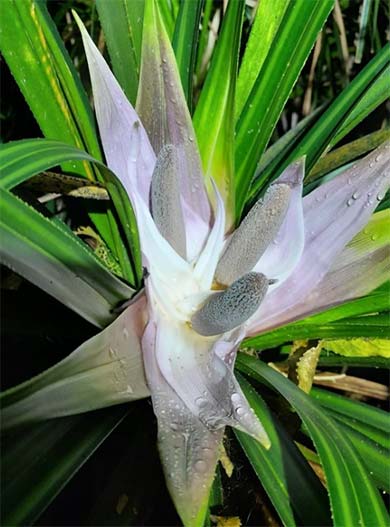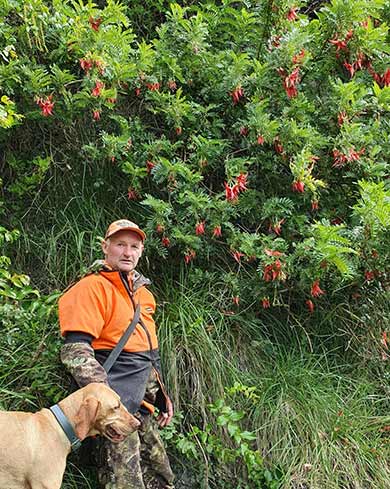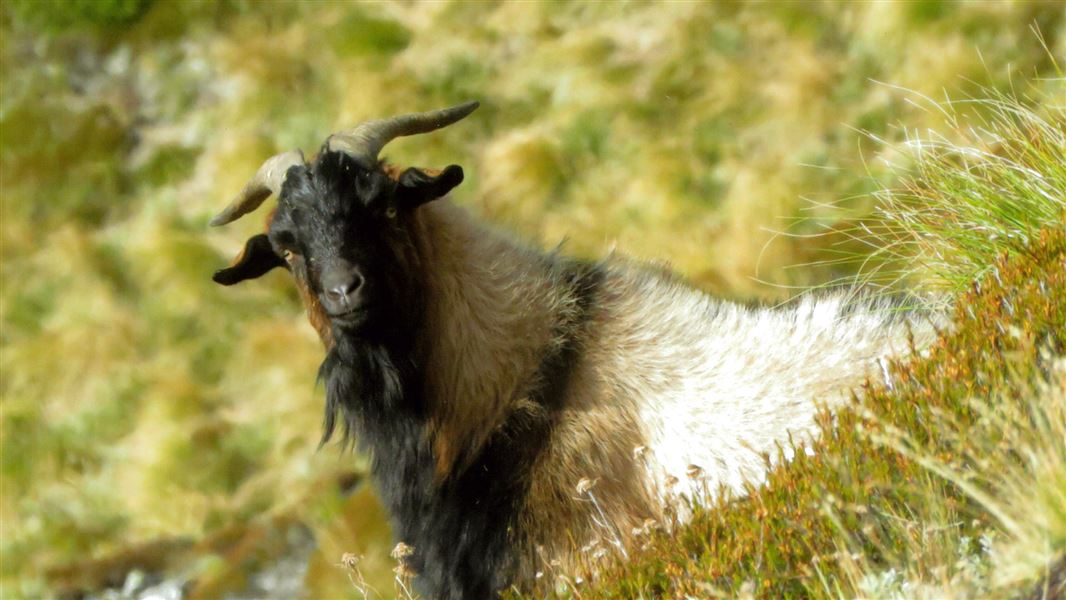On this page:
Goats were introduced to New Zealand in the early days of European settlement for food, to establish a commercial fibre industry, and for weed control on developing land. The descendants of those that escaped or were deliberately released thrived in the country’s grass hills, forest and scrubland areas.
Today wild goats (Capra hircus) occur on both main islands and a few offshore islands. Wild goats are classifed as wild animals under the Wild Animal Control Act 1977.
Facts
Description
Colour wise, they can be white, brown or black, or any combination of these. In New Zealand both sexes have horns. All males and some females are bearded as adults. Males are the largest sex, with clearly heavier forequarters, shaggier coats and larger horns.
Where are they found?
Wild goats are found in a wide range of habitats. They range from sea level to the alpine zone, living in introduced and native grasslands, scrub and forest.
Because they are browsers, their preferred habitat is forest or scrub-covered upland containing areas of grassland. They are agile on steep crags and narrow ledges and can get to areas that deer cannot reach. They like sunny sides of slopes, making use of open places close to the shelter of forest or scrub.
Why are they here?
Goats arrived here as early as 1773, when Captain James Cook released them ashore in the Marlborough Sounds during his second voyage to New Zealand. Early explorers, whalers, sealers and settlers bought goats with them for food, and used them to barter with Māori.
During the late nineteenth - early twentieth century, goats were released onto outlying islands to provide a food source for castaways. Angora goats were introduced about the same time to develop an industry for their fine wool, which never really took off.
As land around the country was ‘developed’, weeds such as gorse, blackberry and briar invaded, and goats were brought in to eat the weeds.
Wild goats now occupy about 14% of New Zealand - about half of this on public conservation land. Total population size is unknown but is estimated to be several hundred thousand.
The threat
New Zealand’s native plants are particularly vulnerable to damage from browsing. Herding browsers such as goats cause two-fold damage by eating native plants and by trampling large areas of vegetation and compactable soils.
Goats will eat the foliage of most trees and plants and quickly destroy all vegetation within their reach, eating seedlings, saplings and litter-fall off the forest floor. They do however have strong preferences and will eat out favoured species first such as broadleaf/pāpāuma (Griselinia littoralis) and māhoe (Melicytus ramiflorus) before moving on to less desirable plants. Goats will also strip bark off trees and by eating young seedlings they effectively put a stop to forest regeneration. This takes vital food and shelter from native animals, and can worsen the effects of climate change.
DOC's work
Government control operations of wild goats began in the 1930s in areas where goats competed with sheep for available grazing. These days, goat control is targeted at areas where their browsing threatens rare native plants or damages the forest understorey.
DOC aims to:
- maintain or achieve wild-goat-free areas
- prevent the spread of wild goats into new areas
- manage their numbers elsewhere to reduce pressure on native plants and habitats.
Different control operations at place
Goat control operations today are based on the biodiversity values at each site, threats present, vegetation impacts, feasibility of control/eradication including the risk of reinvasion from neighbouring land, and other conservation management activities happening at the site.
DOC is working to maintain or achieve wild goat free areas in important conservation areas such as Mount Aspiring National Park, Westland Tai Poutini National Park and Taranaki Maunga. Working to maintain or achieve goat free areas is resource intensive, so in other areas DOC works to try and manage numbers to reduce pressure on native ecosystems such as in Hawke's Bay and South Marlborough.

Goats browse native plants like kiekie.
Image: Taranaki Mounga Project
Mount Aspiring National Park
DOC works to keep wild goats out of the park by conducting operations on southeastern side. This effort has successfully maintained a goat-free status; however, ongoing work is required to maintain this.
Westland Tai Poutini National Park
We are currently investigating the feasibility of completely removing small herds of wild goats from the park. However, complete removal may not always be possible due to the rough terrain, cost, and risk of re-invasion.
Taranaki Maunga
Over the last century, the area has demonstrated the destructive impact non-native wild goats (and possums) have had on Aotearoa New Zealand’s natural ecosystems, and how effective wild animal management strategies can restore ecosystems and help reverse those changes.
Full eradication was achieved in 2022 after an intensive and targeted goat hunting strategy by Taranaki Mounga Project, DOC and the community. It took a co-ordinated team effort to get rid of all goats in five years. The focus will now be on keeping Taranaki goat free and controlling goats in the wider Taranaki District.
The forest understory is now healthy and vegetation is flourishing, with seedlings and saplings growing in places that were previously bare. Taranaki Mounga is a collaboration between DOC, Taranaki iwi chairs forum, and philanthropic investors NEXT Foundation, and Toi Foundation.

Goat culler Wayne Looney next to kākā beak
Image: DOC
Boundary Stream, Hawke's Bay
DOC has worked for over a decade with the Regional Council and a local forestry company to control wild goat numbers around Boundary Stream Mainland Island. Boundary stream is a habitat for several threatened native plants, including the native kākābeak – a plant highly palatable to wild goats.
South Marlborough
DOC undertakes annual wild goat control in South Marlborough. South Marlborough is home to approximately 29 Nationally Critical, 26 Nationally Endangered, and 16 Nationally Vulnerable plant species, including unique limestone communities. These plants and ecosystems threatened by wild goats.
About 5,000 goats are removed each year to reduce pressure on these special ecosystems and prevent their spread to the western side of Molesworth and into Nelson Lakes, which are currently goat free.
Map showing wild goat control work locations
Methods of control
Aerial and ground hunting/shooting are the most common methods used for goat control. Other methods used are trapping and mustering.
DOC uses a combination of professional ground hunters and staff with highly trained indicator or bailing dogs for locating wild goats for removal.
You can help
DOC cannot do this work alone - wild goats are present throughout the country on both public and private land, with significant numbers in some places.
Hunters, landowners, and other agencies can contribute to wild animal management. Through working together, we can make a bigger difference for nature.
If you encounter a wild goat in an area that DOC is working to keep goat free, report it at wildanimalmanagement@doc.govt.nz.
If you are a hunter and can safely remove wild goats, please do so. You only need to report it if the goat is in an area that is meant to be goat free.
Signs goats are present
Tracks show paired hooves with pointed, slightly incurved tips, just like sheep tracks. Faecal pellets can be found singly or in groups and are smooth, an elongated oval shape, rounded at each end – very similar to sheep, sika deer and possums.
The call is a 'meh' rather than a 'baa' (sheep) and rutting males have a pungent smell.1
Te Ara ki Mua Framework for adaptive management of wild animals
Our new adaptive framework has been developed to support the implementation plan for Te Mana o te Taiao – Aotearoa New Zealand Biodiversity Strategy.
The key action of the Framework is to reduce browsing pressure to support ecosystem resilience by:
- improving monitoring, delivery, and evaluation of wild animal management
- coordinating efforts and enhancing capacity across the people, organisations, and agencies involved in wild animal management.
